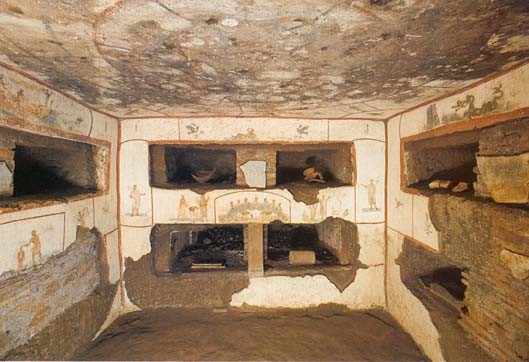Catacomb of St. Calixtus

Address
Via Appia Antica, 110 - 00179 Roma RM
Opening Time
Monday - Tuesday / Thursday - Sunday 09:00 - 12:00 / 14:00 - 17:00
Contact
Tel: +39 06 5130151 / 06 51301580
Email: scallisto@catacombe.roma.it
Sito web: www.catacombe.roma.it
Weeky Closing
Every Wednesday
Annual closing
15 January 2025 - 12 February 2025
How to reach us
ATAC 118, 218
“The catacombs par excellence, the first official cemetery of the Community of Rome, the glorious sepulchre of the popes of the third century” G.B. de Rossi.
The St. Callixtus complex, between the second and third mile of the ancient Appian Way, is made up by above ground cemetery areas with annexed hypogea that can be dated to the end of the second century A.D. These were originally independent from one another and were later connected to form one vast network of community catacombs.
The complex owes its name to the pope and martyr St. Callixtus (217-222) who before his papacy, was entrusted by Pope Zephyrn (199-217) with the administration of the cemetery which was considered the pre-eminent cemetery of the Roman Church, the burial place of many pontiffs and martyrs. Of the many structures that occupied the part above ground only two apsed funeral edifices are still visible: the eastern and the western trichorae. The latter probably housed the tombs of Pope Zephyrn and the martyr Tarsisius.
One of the most ancient and important regions of the catacombs is that of the Popes and of St. Cecilia. Along one gallery of this region the cubicula called “of the Sacraments” developed (first decades of the third century A.D.), which preserve some of the most ancient paintings in the catacombs. In one crypt of the region, almost all the pontiffs of the third century were buried: Pontain, Anterus, Fabian, Lucius, Stephen, Sixtus II, Dionysius, Felix and Eutychian. Next to the crypt of the Popes, the crypt of St. Cecilia is found to whom a cult was attributed especially in the high middle ages.
Some other regions with catacombs of importance are those of: Pope St. Cornelius (251-253), who died in exile in Civitavecchia; Pope St. Miltiades (311-314); Popes Sts. Gaius (283-296) and Eusebius (309), and the so-called “Liberian” catacomb because of the many inscriptions from the era of Pope St. Liberius (352-366).


